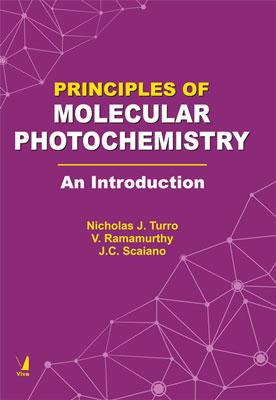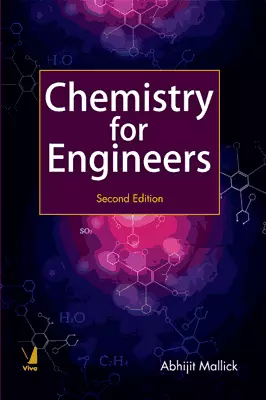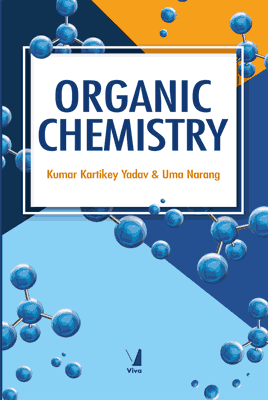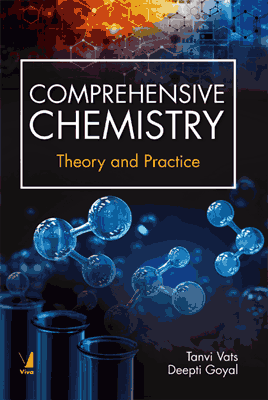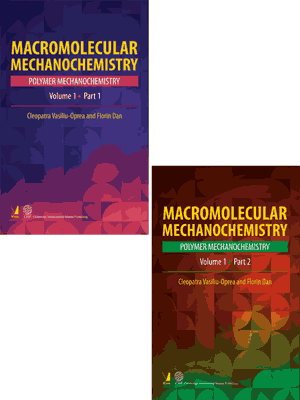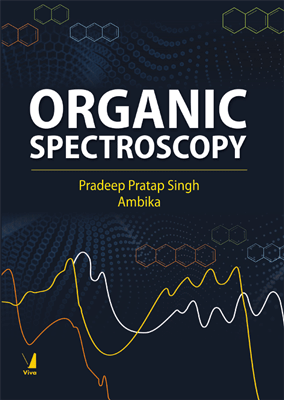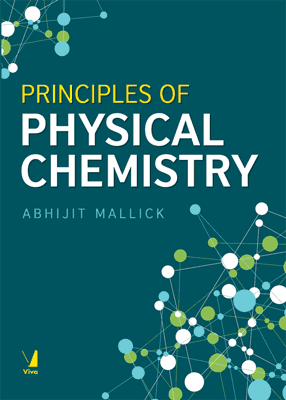Principles of Molecular Photochemistry
Principles of Molecular Photochemistry
An Introduction
₹625.50 ₹695.00 Save: ₹69.50 (10%)
Go to cartISBN: 9788130928814
Bind: Paperback
Year: 2020
Pages: 520
Size: 171 x 242 mm
Publisher: University Science Books
Published in India by: Viva Books
Exclusive Distributors: Viva Books
Sales Territory: India, Nepal, Pakistan, Bangladesh, Sri Lanka
Review:
Exceptionally thorough and well written, Principles of Molecular Photochemistry will be useful to every active researcher in the field. Filled with reference material for experts, the book also gives an excellent introduction to photochemical reactivity for students.
Malcolm Forbes, University of North Carolina, Chapel Hill
Description:
Developed from Nick Turro's best-selling text for three decades, Modern Molecular Photochemistry, this book develops photochemical and photophysical concepts from a small set of familiar principles and provides clear descriptions in pictorial terms. This text will be of interest to not only practicing photochemists and their students, but also to biological scientists, polymer scientists, material scientists and nanoscientists.
Target Audience:
This text will be of interest to not only practicing photochemists and their students, but also to biological scientists, polymer scientists, material scientists and nanoscientists.
Contents:
CHAPTER 1: Molecular Photochemistry of Organic Compounds: An Overview • What Is Molecular Organic Photochemistry? • Learning Molecular Organic Photochemistry through the Visualization of Molecular Structures and the Dynamics of Their Transformations • Why Study Molecular Organic Photochemistry? • The Value of Pictorial Representations and Visualization of Scientific Concepts • Scientific Paradigms of Molecular Organic Photochemistry • Exemplars as Guides to the Experimental Study and Understanding of Molecular Organic Photochemistry • The Paradigms of Molecular Organic Photochemistry • Paradigms as Guides for Proceeding from the Possible to the Plausible to the Probable Photochemical Processes • Some Important Questions that Will Be Answered by the Paradigms of Molecular Organic Photochemistry • From a Global Paradigm to the Everyday Working Paradigm • Singlet States, Triplet States, Diradicals, and Zwitterions: Key Structures Along a Photochemical Pathway from *R to P • State Energy Diagrams: Electronic and Spin Isomers • An Energy Surface Description of Molecular Photochemistry • Structure, Energy, and Time: Molecular-Level Benchmarks and Calibration Points of Photochemical Processes • Calibration Points and Numerical Benchmarks for Molecular Energetics • Counting Photons • Computing the Energy of a Mole of Photons for Light of Wavelength • and Frequency • ? The Range of Photon Energies in the Electromagnetic Spectrum • Calibration Points and Numerical Benchmarks for Molecular Dimensions and Time Scales • Plan of the Text • References
CHAPTER 2: Electronic, Vibrational, and Spin Configurations of Electronically Excited States • Visualization of the Electronically Excited Structures through the Paradigms of Molecular Organic Photochemistry • Molecular Wave Functions and Molecular Structure • The Born?Oppenheimer Approximation: A Starting Point for Approximate Molecular Wave Functions and Energies • Important Qualitative Characteristics of Approximate Wave Functions • From Postulates of Quantum Mechanics to Observations of Molecular Structure: Expectation Values and Matrix Elements • The Spirit of the Use of Quantum Mechanical Wave Functions, Operators, and Matrix Elements • From Atomic Orbitals, to Molecular Orbitals, to Electronic Configurations, to Electronic States • Ground and Excited Electronic Configurations • The Construction of Electronic States from Electronic Configurations • Construction of Excited Singlet and Triplet States from Electronically Excited Configurations and the Pauli Principle • Characteristic Configurations of Singlet and Triplet States: A Shorthand Notation • Electronic Energy Difference between Molecular Singlet and Triplet States of *R: Electron Correlation and the Electron Exchange Energy • Evaluation of the Relative Singlet and Triplet Energies and Singlet? Triplet Energy Gaps for Electronically Excited States (*R) of the Same Electronic Configuration • Exemplars for the Singlet?Triplet Splittings in Molecular Systems • Electronic Energy Difference between Singlet and Triplet States of Diradical Reactive Intermediates: Radical Pairs, I(RP), and Biradicals, I(BR) • A Model for Vibrational Wave Functions: The Classical Harmonic Oscillator • The Quantum Mechanical Version of the Classical Harmonic Oscillator • The Vibrational Levels of a Quantum Mechanical Harmonic Oscillator • The Vibrational Wave Functions for a Quantum Mechanical Harmonic Oscillator: Visualization of the Wave Functions for Diatomic Molecules • A First-Order Approximation of the Harmonic-Oscillator Model: The Anharmonic Oscillator • Building Quantum Intuition for Using Wave Functions • Electron Spin: A Model for Visualizing Spin Wave Functions • A Vector Model of Electron Spin • Important Properties of Vectors • Vector Representation of Electron Spin • Spin Multiplicities: Allowed Orientations of Electron Spins • Vector Model of Two Coupled Electron Spins: Singlet and Triplet States • The Uncertainty Principle and Cones of Possible Orientations for Electron Spin • Cones of Possible Orientations for Two Coupled 1/2 Spins: Singlet and Triplet Cones of Orientation as a Basis for Visualizing the Interconversion of Spin States • Making a Connection between Spin Angular Momentum and Magnetic Moments Due to Spin Angular Momentum • The Connection between Angular Momentum and Magnetic Moments: A Physical Model for an Electron with Angular Momentum • The Magnetic Moment of an Electron in a Bohr Orbit • The Connection between Magnetic Moment and Electron Spin • Magnetic Energy Levels in an Applied Magnetic Field for a Classical Magnet • Quantum Magnets in the Absence of Coupling Magnetic Fields • Quantum Mechanical Magnets in a Magnetic Field: Constructing a Magnetic State Energy Diagram for Spins in an Applied Magnetic Field • Magnetic Energy Diagram for a Single Electron Spin and for Two Coupled Electron Spins • Magnetic Energy Diagrams Including the Electron Exchange Interaction, J • Interactions between Two Magnetic Dipoles: Orientation and Distance Dependence of the Energy of Magnetic Interactions • Summary: Structure and Energetics of Electrons, Vibrations, and Spins • References
CHAPTER 3: Transitions between States: Photophysical Processes • Transitions between States • A Starting Point for Modeling Transitions between States • Classical Chemical Dynamics: Some Preliminary Comments • Quantum Dynamics: Transitions between States • Perturbation Theory • The Spirit of Selection Rules for Transition Probabilities • Nuclear Vibrational Motion As a Trigger for Electronic Transitions Vibronic Coupling and Vibronic States: The Effect of Nuclear Motion on Electronic Energy and Electronic Structure • The Effect of Vibrations on Transitions between Electronic States: The Franck?Condon Principle • A Classical and Semiclassical Harmonic Oscillator Model of the Franck?Condon Principle for Radiative Transitions (R + h? -> *R and *R -> R + h?) • A Quantum Mechanical Interpretation of the Franck?Condon Principle and Radiative Transitions • The Franck?Condon Principle and Radiationless Transitions • (*R -> R + heat) • Radiationless and Radiative Transitions between Spin States of Different Multiplicity • Spin Dynamics: Classical Precession of the Angular Momentum Vector • Precession of a Quantum Mechanical Magnet in the Cones of Possible Orientations • Important Characteristics of Spin Precession • Some Quantitative Benchmark Relationships between the Strength of a Coupled Magnetic Field and Precessional Rates • Transitions between Spin States: Magnetic Energies and Interactions • The Role of Electron Exchange (J) in Coupling Electron Spins • Couplings of a Spin with a Magnetic Field: Visualization of Spin Transitions and Intersystem Crossing • Vector Model for Transitions between Magnetic States • Spin?Orbit Coupling: A Dominant Mechanism for Inducing Spin Changes in Organic Molecules • Coupling of Two Spins with a Third Spin: T+ -> S and T- -> S Transitions • Coupling Involving Two Correlated Spins: T0 ->S Transitions • Intersystem Crossing in Diradicals, I(D): Radical Pairs, I(RP), and Biradicals, I(BR) • Spin?Orbit Coupling in I(D): The Role of Relative Orbital Orientation • Intersystem Crossing in Flexible Biradicals • What All Transitions between States Have in Common • References
CHAPTER 4: Radiative Transitions between Electronic States • The Absorption and Emission of Light by Organic Molecules • The Nature of Light: A Series of Paradigm Shifts • Black-Body Radiation and the "Ultraviolet Catastrophe" and Planck's Quantization of Light Energy: The Energy Quantum Is Postulated • The "Photoelectric Effect" and Einstein's Quantization of Light???The Quantum of Light: Photons • If Light Waves Have the Properties of Particles, Do Particles Have the Properties of Waves? ???de Broglie Integrates Matter and Light • Absorption and Emission Spectra of Organic Molecules: The State Energy Diagram as a Paradigm for Molecular Photophysics • Some Examples of Experimental Absorption and Emission Spectra of Organic Molecules: Benchmarks • The Nature of Light: From Particles to Waves to Wave Particles • A Pictorial Representation of the Absorption of Light • The Interaction of Electrons with the Electric and Magnetic Forces of Light • A Mechanistic View of the Interaction of Light with Molecules: Light as a Wave • An Exemplar of the Interaction of Light with Matter: The Hydrogen Atom • From the Classical Representation to a Quantum Mechanical Representation of Light Absorption by a Hydrogen Atom and a Hydrogen Molecule • Photons as Massless Reagents • Relationship of Experimental Spectroscopic Quantities to Theoretical Quantities • The Oscillator Strength Concept • The Relationship between the Classical Concept of Oscillator Strength and the Quantum Mechanical Transition Dipole Moment • Examples of the Relationships of e, k0e , t0e ,< ?1 |P| ?2 >, and f • Experimental Tests of the Quantitative Theory Relating Emission and Absorption to Spectroscopic Quantities • The Shapes of Absorption and Emission Spectra • The Franck?Condon Principle and Absorption Spectra of Organic Molecules • The Franck?Condon Principle and Emission Spectra • The Effect of Orbital Configuration Mixing and Multiplicity Mixing on Radiative Transitions • Experimental Exemplars of the Absorption and Emission of Light by Organic Molecules • Absorption, Emission, and Excitation Spectra • Order of Magnitude Estimates of Radiative Transition Parameters • Quantum Yields for Emission (*R -> R + h?) • Experimental Examples of Fluorescence Quantum Yields • Determination of "State Energies" ES and ET from Emission Spectra • Spin?Orbit Coupling and Spin-Forbidden Radiative Transitions • Radiative Transitions Involving a Change in Multiplicity: • SO <-> T(n,p*) and SO <-> T(p,p*) Transitions as Exemplars • Experimental Exemplars of Spin-Forbidden Radiative Transitions: SO -> T1Absorption and T1 -> S Phosphorescence • Quantum Yields of Phosphorescence, • P: The T1 -> SO + h? Process • Phosphorescence in Fluid Solution at Room Temperature • Absorption Spectra of Electronically Excited States • Radiative Transitions Involving Two Molecules: Absorption Complexes and Exciplexes • Examples of Ground-State Charge-Transfer Absorption Complexes • Excimers and Exciplexes • Exemplars of Excimers: Pyrene and Aromatic Compounds • Exciplexes and Exciplex Emission • Twisted Intramolecular Charge-Transfer States • Emission from "Upper" Excited Singlets and Triplets: The Azulene Anomaly • References
CHAPTER 5: Photophysical Radiationless Transitions • Photophysical Radiationless Transitions As a Form of Electronic Relaxation • Radiationless Electronic Transitions as the Motion of a Representative Point on Electronic Energy Surfaces • Wave Mechanical Interpretation of Radiationless Transitions between States • Radiationless Transitions and the Breakdown of the Born?Oppenheimer Approximation • An Essential Difference between Strongly Avoiding and Matching Surfaces • Conical Intersections Near Zero-Order Surface Crossings • Formulation of a Parameterized Model of Radiationless Transitions • Visualization of Radiationless Transitions Promoted by Vibrational Motion; Vibronic Mixing • Intersystem Crossing: Visualization of Radiationless Transitions Promoted by Spin?Orbit Coupling • Selection Rules for Intersystem Crossing in Molecules • The Relationship of Rates and Efficiencies of Radiationless Transitions to Molecular Structure: Stretching and Twisting as Mechanisms for Inducing Electronic Radiationless Transitions • The "Loose Bolt" and "Free-Rotor" Effects: Promoter and Acceptor Vibrations • Radiationless Transitions between "Matching" Surfaces Separated by Large Energies • Factors That Influence the Rate of Vibrational Relaxation • The Evaluation of Rate Constants for Radiationless Processes from Quantitative Emission Parameters • Examples of the Estimation of Rates of Photophysical Processes from Spectroscopic Emission Data • Internal Conversion (Sn -> S1, S1 -> SO, Tn -> T1) • The Relationship of Internal Conversion to the Excited-State Structure of *R • The Energy Gap Law for Internal Conversion (S1 -> SO) • The Deuterium Isotope Test for Internal Conversion • Examples of Unusually Slow Sn -> S1 Internal Conversion • Intersystem Crossing from S1 -> T1 • The Relationship Between S1 -> T1 Intersystem Crossing and Molecular Structure • Temperature Dependence of S1 -> Tn Intersystem Crossing • Intersystem Crossing (T1 -> SO) • The Relationship between T1 ->SO Intersystem Crossing and Molecular Structure • The Energy Gap Law for T1 -> SO Intersystem Crossing: Deuterium Isotope Effects on Interstate Crossings • Perturbation of Spin-Forbidden Radiationless Transitions • Internal Perturbation of Intersystem Crossing by the Heavy-Atom Effect • External Perturbation of Intersystem Crossing • The Relationship between Photophysical Radiationless Transitions and Photochemical Processes • References
CHAPTER 6: A Theory of Molecular Organic Photochemistry • Introduction to a Theory of Organic Photoreactions • Potential Energy Curves and Surfaces • Movement of a Classical Representative Point on a Surface • The Influence of Collisions and Vibrations on the Motion of the Representative Point on an Energy Surface • Radiationless Transitions on PE Surfaces: Surface Maxima, Surface Minima, and Funnels on the Way from *R to P • A Global Paradigm for Organic Photochemical Reactions • Toward a General Theory of Organic Photochemical Reactions Based on Potential Energy Surfaces • Determining Plausible Molecular Structures and Plausible Reaction Pathways of Photochemical Reactions • The Fundamental Surface Topologies for "Funnels" from Excited Surfaces to Ground-State Surfaces: Spectroscopic Minima, Extended Surface Touchings, Surface Matchings, Surface Crossings, and Surface Avoidings • From 2D PE Curves to 3D PE Surfaces: The "Jump" from Two Dimensions to Three Dimensions • The Nature of Funnels Corresponding to Surface Avoidings and Surface Touchings Involved in Primary Photochemical Processes • "The Noncrossing Rule" and Its Violations: Conical Intersections and Their Visualization • Some Important and Unique Properties of Conical Intersections • Diradicaloid Structures and Diradicaloid Geometries • Diradicaloid Structures Produced from Stretching s Bonds and Twisting p Bonds • An Exemplar for Diradicaloid Geometries Produced by s-Bond Stretching and Bond Breaking: Stretching of the s Bond of the Hydrogen Molecule • An Exemplar for Diradicaloid Geometries Produced by p-Bond Twisting and Breaking: Twisting of the p Bond of Ethylene • Frontier Orbital Interactions As a Guide to the Lowest-Energy Pathways and Energy Barriers on Energy Surfaces • The Principle of Maximum Positive Orbital Overlap for Frontier Orbitals • Stabilization by Orbital Interactions: Selection Rules Based on Maximum Positive Overlap and Minimum Energy Gap • Commonly Encountered Orbital Interactions in Organic Photoreactions • Selection of Reaction Coordinates from Orbital Interactions for *R -> I or *R -> F -> P Reactions: Exemplars of Concerted Photochemical Reactions and Photochemical Reactions That Involve Diradicaloid Intermediates • Electronic Orbital and State Correlation Diagrams • An Exemplar for Photochemical Concerted Pericyclic Reactions: The Electrocyclic Ring Opening of Cyclobutene and Ring Closure of 1,3-Butadiene • Frontier Orbital Interactions Involving Radicals as Models for Half-Filled Molecular Orbitals • Orbital and State Correlation Diagrams • The Construction of Electronic Orbital and State Correlation Diagrams for a Selected Reaction Coordinate • Typical State Correlation Diagrams for Concerted Photochemical Pericyclic Reactions • Classification of Orbitals and States for the Electrocyclic Reactions of Cyclobutene and 1,3-Butadiene: An Exemplar Concerted Reaction • Concerted Photochemical Pericyclic Reactions and Conical Intersections • Typical State Correlation Diagrams for Nonconcerted Photoreactions: Reactions Involving Intermediates (Diradicals and Zwitterions) • Natural Orbital Correlation Diagrams • The Role of Small Barriers in Determining the Efficiencies of Photochemical Processes • An Exemplar for the Photochemical Reactions of n,p* States • The Symmetry Plane Assumption: Salem Diagrams • An Exemplar State Correlation Diagram for n-Orbital Initiated • Reaction of n,p* States: Hydrogen Abstraction via a Coplanar Reaction Coordinate • Extension of an Exemplar State Correlation Diagram to New Situations • State Correlation Diagrams for a-Cleavage of Ketones • A Standard Set of Plausible Primary Photoreactions for p,p* and n,p* States • The Characteristic Plausible Primary Photochemistry Processes of p,p* States • The Characteristic Plausible Primary Photochemical Processes of n,p* States • Summary: Energy Surfaces as Reaction Graphs or Maps • References
CHAPTER 7: Energy Transfer and Electron Transfer • Introduction to Energy and Electron Transfer • The Electron Exchange Interaction for Energy and Electron Transfer • "Trivial" Mechanisms for Energy and Electron Transfer • Energy Transfer Mechanisms • Visualization of Energy Transfer by Dipole?Dipole Interactions: A Transmitter?Antenna Receiver?Antenna Mechanism • Quantitative Aspects of the Forster Theory of Dipole?Dipole Energy Transfer • The Relationship of kET to Energy-Transfer Efficiency and Separation of Donor and Acceptor RDA • Experimental Tests for Dipole?Dipole Energy Transfer • Electron Exchange Processes: Energy Transfer Resulting from Collisions and Overlap of Electron Clouds • Electron Exchange: An Orbital Overlap or Collision Mechanism of Energy Transfer • Electron-Transfer Processes Leading to Excited States • Triplet?Triplet Annihilation (TTA): A Special Case of Energy Transfer via Electron Exchange Interactions • Electron Transfer: Mechanisms and Energetics • Marcus Theory of Electron Transfer • A Closer Look at the Reaction Coordinate for Electron Transfer • Experimental Verification of the Marcus Inverted Region for Photoinduced Electron Transfer • Examples of Photoinduced Electron Transfer That Demonstrate the Marcus Theory • Long-Distance Electron Transfer • Mechanisms of Long-Distance Electron Transfer: Through-Space and Through-Bond Interactions • A Quantitative Comparison of Triplet?Triplet Energy and Electron Transfer • A Connection between Intramolecular Electron, Hole, and Triplet Transfer • Photoinduced Electron Transfer between Donor and Acceptor Moieties Connected by a Flexible Spacer • Experimental Observation of the Marcus Inversion Region for Freely Diffusing Species in Solution • Control of the Rate and Efficiency of Electron-Transfer Separation by Controlling Changes in the Driving Force for Electron Transfer • Application of Marcus Theory to the Control of Product Distributions • The Continuum of Structures from Charge Transfer to Free Ions: Exciplexes, Contact Ion Pairs, Solvent Separated Radical Ion Pairs, and Free Ion Pairs • Comparison between Exciplexes and Contact Radical Ion Pairs • Electron-Transfer Equilibria • Energy-Transfer Equilibria • Electron-Transfer Equilibria in the Ground State • Excited-State Electron-Transfer Equilibria • Excited-State Formation Resulting from Electron-Transfer Reactions: Chemiluminescent Reactions • Role of Molecular Diffusion in Energy and Electron-Transfer Processes in Solution • An Exemplar Involving Energy Transfer Controlled by Diffusion • Estimation of Rate Constants for Diffusion Controlled Processes • Examples of Near-Diffusion-Controlled Reactions: Reversible Formation of Collision Complexes • The Cage Effect • Distance?Time Relationships for Diffusion • Diffusion Control in Systems Involving Charged Species • Summary • References • Index
About the Authors:
Nicholas J. Turro is the William P. Schweitzer Professor of Chemistry at Columbia University. He has been widely recognized by national and International awards as a leader and pioneer in the area of supramolecular chemistry, organic photochemistry, molecular spectroscopy, host-guest chemistry and magnetic effects on photochemical reactions.
V. Ramamurthy (Murthy) is currently Professor and Chair of Chemistry at University of Miami, Florida. He has held appointments at Indian Institute of Science, Bangalore, The Du Pont Company and Tulane University. He is well-known for his contributions in the area of solidstate chemistry, supramolecular chemistry and organic photochemistry.
J.C. (Tito) Scaiano holds the Canada Research Chair in Applied Photochemistry at the University of Ottawa. He is widely recognized for his work on mechanisms in photochemistry and physical organic chemistry. His current research interests include the application of these fields to nanochemistry, imaging, chemical sensors, and the health sciences.
About the Authors:
Nicholas J. Turro is the William P. Schweitzer Professor of Chemistry at Columbia University. He has been widely recognized by national and International awards as a leader and pioneer in the area of supramolecular chemistry, organic photochemistry, molecular spectroscopy, host-guest chemistry and magnetic effects on photochemical reactions.
V. Ramamurthy (Murthy) is currently Professor and Chair of Chemistry at University of Miami, Florida. He has held appointments at Indian Institute of Science, Bangalore, The Du Pont Company and Tulane University. He is well-known for his contributions in the area of solidstate chemistry, supramolecular chemistry and organic photochemistry.
J.C. (Tito) Scaiano holds the Canada Research Chair in Applied Photochemistry at the University of Ottawa. He is widely recognized for his work on mechanisms in photochemistry and physical organic chemistry. His current research interests include the application of these fields to nanochemistry, imaging, chemical sensors, and the health sciences.
